“It was thanks to Stella that Aussies and Kiwis defeated the Pils-drinking Germans at Alamein!”
John Deeny, Perth, Australia
“My one fun memory of Stella: using the bottle size to date deposits at archaeological sites!!!”
Salima Ikram, Archaeologist, Cairo Egypt
“I really miss the big bottles from the old days. A couple of those and you were a happy soul. That is if they weren’t flat!”
Barry Iverson, Photographer, Cairo Egypt
“Gone are the days when I could devote five hours every evening to the consumption and appreciation of Stella.”
Steve Negus, Journalist, Los Angeles California
“If Arak was not available, the affordable bottle of Stella (7.5 piasters!!!) always took precedence at the Kit-Kat Club, the Dahabia, the Parisienne, Badia, or Casino al-Shagara. Not a Christmas or Shabbat passed where Stella was not present on the table whenever there were guests. Sham al Nessim would inevitably mean fessikh (dried fish) with Stella.”
Desire Sakkal, Brooklyn, New York
“When I attended the Schultz American school in Alexandria in 1973 – 1974, I used to go on weekend nights with some of my classmates to a nightclub on the Corniche. There, we consumed large volumes of Stella beer and partied, danced, and staggered back to the campus before curfew. I remember the large size of the Stella bottles, the distinct label and the smooth taste of the beer. During the 1973 October War, we were confined to the school compound for our own safety.”
Stephen Griffin, Retired, Washington DC
I’ve always loved the bottles that Stella comes in. I love the size of them, the green and brown glass, and the beautifully simple yellow label with blue star. It’s a design classic. Forget the Pyramids, nothing says Egypt to me like a Stella bottle. I was worried for a while in the 1990s when Al-Ahram Beverages introduced aluminium cans but happily they’re just for the folk in Zamalek and denizens of the Downtown bars have remained unaffected.
Andrew Humphreys, London, England, www.grandhotelsegypt.com
“It was a cold Saturday. From my window overlooking Soliman Pasha Street, in downtown Cairo, I watched as an unruly mob ransacked the Stella depot near Café Riche and proceeded towards nearby Groppi. A few minutes later Cairo was going up in smoke as major department stores, clubs, airline offices and cinemas were torched. January 26 1952, from that day onwards was referred to as Black Saturday. The days of King Farouk were numbered.”
Henri Barda, Concert Pianist, Paris, France
“I lived in Ibrahmieh in my teens. My mother used to send me to the brewery to buy yeast for her baking. My father preferred the contents of the bottles, but they figured rarely on our table. The family would often sit at a café on the Corniche and there would always be some Stella to accompany the plentiful mezze…
I have tried to find a beer in the UK that has a similar flavour to the Alexandria Stella, the nearest I found is the Mythos from Greece. I always buy it when I find it, but then Mythos is best served by the sea in Greece…
I was born in Alexandria in 1944 and departed in 1967.”
Marcos Vital, UK
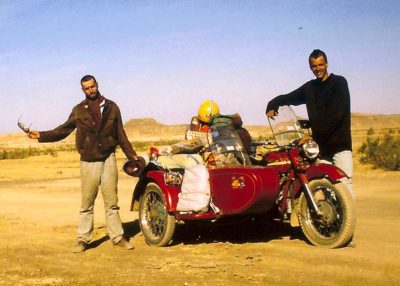
Mark Ehlen (R) and Norbert Schiller pose for a photograph after arriving to Wadi Halfa, Sudan, in January 1987
“Riding with my buddy on our Russian Ural Moto motorcycle with sidecar on the banks of the River Nile, we would pass farm after farm warming to the rising sun in the foggy morning and baking in the heat of the afternoon. For a couple of Westerners like us, stops at the occasional cafe were the highlight of the day. The simple but exotic chai tea with its spice and sweetness warmed the mornings, but having a Stella beer in the afternoon cut through the heat and dirt of riding all day.”
Mark Ehlen, Engineer, Albuquerque, New Mexico
“When I came to Cairo in 1994, I quickly learned never to buy just one Stella, but a case of big green (and sometimes brown) bottles. The reason why we bought so many wasn’t that we were having a party; it’s that only every fourth bottle had carbonation! Every once in a blue moon we would get a case that seemed 100%, but it tasted funny. Rumor had it that Stella put formaldehyde into the beer to give it a head!”
Andrew Tabler, Senior Fellow, Washington DC

Tim Powell enjoying Stella with his wife Eve in the desert with the Pyramids somewhere in the distance, 1991
“What makes Stella beer so special is not only its fine flat taste but its power to call up memories of people and places. Here my wife, Eve Troutt-Powell, and I are enjoying Cairo’s classic beer with Norbert Schiller in the middle of the desert with the pyramids on the horizon. The image summons the indescribable pleasure of a cold beer on a scorching hot day but, more than that, the laughter and giddy freedom of that remarkable time when you are just beginning to become who you had always hoped you would be. We set out in search of our fortune and found it with the help of a cold Stella and few good friends.”
Timothy Powell, University Professor, Philadelphia, Pennsylvania
“In the winter of 1981, when things were tense in Egypt following the assassination of Anwar Sadat, I was enrolled at AUC. As a diversion I signed up for a small part in a school play – (Tennessee) William’s “Streetcar Named Desire” — as a delivery boy. I had four lines in a three-hour play. The highlight of the play is when Stanley falls to his knees and pleads for his wife to return to him — he yells Stella!!!! Well one of the lovely Egyptian actors approached me after opening night and whispered Stella in my ear — which I took as mimicking the play, but she meant it as an invitation to have a cold beer. Her view prevailed. And that’s why Stella remains one of my favorites.”
Steve Lamon, Lawyer, Yuba City, California
“My memories of Stella are frankly very warm. The beer went through a period of tasting absolutely awful – there would be occasions where you would sheepishly return bottle after bottle to waiters because they tasted like pineapple juice. Basically, entire crates seemed to have gone off. It didn’t really cause too many arguments, because no one could deny there was something seriously wrong with Stella production at that time in the 1990s. But things changed drastically with new management, and what was nice is that the beer still retained a distinctive character; it didn’t become another globalized variety. You think of Egypt and, if you’re a beer-drinker, you think of Stella. Once as a tragic joke, now as something to look forward to drinking!”
Andrew Hammond, Senior Fellow, London, UK
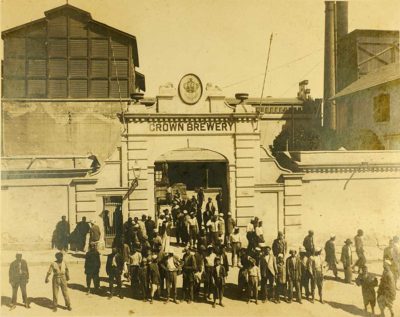
The front gate of Crown Brewery facing Eleusis Street in the 1920s and 1930s.
“I was living at no. 24 Eleusis (Abdel Moneim Sanad) Street which ran between the tramway station of Camp Caesar near Cinema Odeon and ended at the electricity company at Aboukir Street. In between but closer to Aboukir Street was the Stella brewery facing my house. From our balcony we could have a good view of the factory, the offices, and the main gate. In short, we were aware of everything happening there. We could also smell the fermented malt, especially toward the end of summer when the aroma was more pronounced with the Marzan beer. We used to see the long queues of local resellers (bawabs) with their wooden carts filled with empty bottles trying to exchange them for new ones. Most bawabs in Alexandria in those days used to carry a small wooden box filled with ice and bottles of Spathis, Vimto, and of course Stella beer. The trucks carrying the empty bottles used to be driven in through the main gate and they kept on getting bigger and bigger, so the company had to widen the gate because most of the time the trucks would hit the wall and some bottles would break.”
Mike Stamford, Lincolnshire, UK
“My earliest memory of Stella was when I used to walk across the Qasr al-Nil bridge coming from al-Jazeera, now called Zamalek, toward Tahrir Square. On the right hand side, just past the lions, there was a building with one of the largest Stella ad panels on its side wall. This was in 1956 or 1957. I was so small that I could only enjoy the view of the Nile through the openings of the metal railing on the sides of the bridge. But my family would sometimes stop to lift me up so I could look over the railing. In the distance, towards what is now the May 15th bridge, was another of my favorite ads, the circular Pepsi Cola logo that flickered at night. But the Pepsi ad couldn’t hold a candle to its captivating Stella rival with its three flickering stars and gigantic bottle.
The building was torn down in the mid-1960s to make room for a tunnel that links Garden City to the Corniche. I recently saw the ad again in an old black and white Egyptian film. I replayed the scene several time to watch this image of the distant past. The three stars flickered in sequence, green and white against a dark and clear sky. Back then the sky was so clear that we could actually see the stars. But in the eyes of a five-year old, these couldn’t compete with the dazzling lights of an artificial contraption on the side of a building that would soon be relegated to incidental shots in old films.”
Nabil Shawkat, Washington DC
“I remember once in my Dokki flat we decided to do a thorough cleaning of the kitchen. For about five years, my flatmates and I had been stashing used bottles in various corners, thinking we’d bring them back to the liquor store some day and get a couple hundred pounds or so. There were Stellas in the corners. There were Stellas under the sink. There were Stella bottles in a slot between the refrigerator and the roof. When we took them down, there were probably about a thousand bottles or more – enough to fill up a good sized front room. We started arranging them in formation. My flatmate Ehab, a photographer, took some pictures. It was pretty impressive, our army of Stella bottles, green and brown, on a hardwood floor with the mirrors reflecting the light, but we thought it might be fun to try to do some sort of diorama, high modernist Nasserist-inspired social realism, with different Stella bottles standing in for different sectors of Egyptian society. The ordinary Stellas would be the working shaab; the Stella Exports would be the Infitah elite doing import substitution projects with Gulf money; the Stella premiums would be building golf courses in the desert, and behind it all would stand the agdad, the ancestors, in Pharaonic garb, the big 1000ml pre-1990s bottles looking proudly on the new era. Ultimately, however, we needed the room for a Ping-Pong table, so the zabbaleen (garbage collectors) made a special trip one day and cleared them out. They were pretty happy with the haul, if I recall.”
Steve Negus, Los Angeles, California
“Oh, my Sweet Stella! My first Stella was in the Dark Ages of public sector ownership. The Cairo Rugby Club t-shirt had a Stella logo and in big bold letters: ‘That which doesn’t t kill us, will only make us stronger!’ True dat.
But then our European brew masters came along – with their Egyptian counterparts – and started brewing up a storm. And my beloved Stella started shining like the star she is! Delicious. Passionate. A half-liter of joy and blessings; quench my thirst; cool my fire; warm my heart.
We had a real extravaganza celebrating the 100th Year Anniversary of the brewery, and the first anniversary of the privatization. We held it on the grounds of the Great Pyramids. Wow. The Who’s Who of Egypt was there. We got permission from the Air Force to clear air space overhead – and we literally shined the Stella logo onto the Great Pyramid!
I had the most interesting conversations while drinking Stella: With street-smart bo’abs (like the New York ‘Super’) musing about life in Egypt; Fellaheen (farmers), waxing about their toil in the fields; radical leftists at the Greek Club, pining for a new government; Journalists, dignitaries, investors, intellectuals, socialites; People from all walks of life, all over the world, all different perspectives and points of view. But what we all have in common – we love Stella.”
Steve Keefer, Former Financial Advisor to Ahmed Zayat; now CEO at U.S. Elite, New Jersey
“Stella used to come in big bottles –really big bottles –and they were cheap, only three pounds in the fall of 1991. We could, and did, buy it almost anywhere, but the preferred merchant was an amiable bawab in Bab el Louk who sold Stella at all hours of the night. Anyway, the big and cheap aspect of Stella, which made this fine beer a great value, also gave it a darker side. One Saturday night a friend called to say he was having a party, and asked if we could pick up some Stella. He frantically explained that there were a lot of people at his place and more were coming, so he needed more Stella –now. Panic-stricken at the thought that his tallaga (fridge) had nothing but flat soda and Baraka water bottles, we grabbed two suitcases and headed toward our favorite bawab. Twenty minutes later, we were standing in the lobby of our friend’s building with two suitcases bulging with Stellas. We came close to tears when we saw a large, handwritten sign on the elevator that read atlan –out of order, and our friend’s apartment was on the 19th floor. This is when the dark side of Stella revealed itself to us for the first time. It was also the first time we wished that Stella came in a smaller size. When we finally reached our friend’s apartment sweaty and broken, we found him sitting alone. There was no party. There weren’t even any plans for one. He wanted Stella, but he didn’t want to carry it up 19 floors. If he could get us to bring some up, he thought, we might as well bring a lot. In the end, Stella taught me two valuable lessons: bigger isn’t always better and never make friends with people who live above the third floor.”
Josh Mortensen, Frisco, Colorado
“When I moved to Egypt in 1996, I was already a big fan of beer. I enjoyed Guinness and tended to be drawn toward the more robust fare. Anyone who was in Egypt around that time knows that Stella was less than stellar. I suffered through many encounters with “floaters” in unopened bottles. The occasional cigarette butt stuck to the bottom of an unopened bottle simply meant you would move on to another bottle. The straw that broke the camel’s back – and I actually think this is the first time my use of that saying is geographically accurate – was when a group of friends and I were at a bar and, as a fresh round of Stellas arrived, we no longer felt thirsty. There, floating near the bottom of the bottle was a used bandaid. That did it. That’s when a friend of mine and I hatched a plan to begin home brewing.
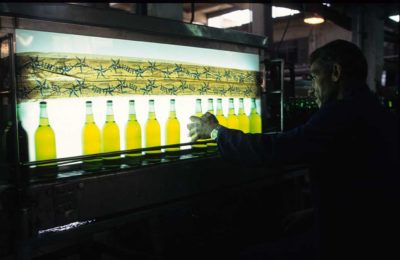
An employee at Al Ahram Beverages Inspecting full bottles of Stella beer for “floaters” in 1997.
Several weeks later, we discreetly imported a home brewing kit which my friend brought into the country in an oversized backpack. I was responsible for bringing in the brewing ingredients – canned hops, barley, and flavor packs. Motivated by the memory of that floating bandaid, we began brewing immediately.
As we hunched over our stove, gently steeping a bag of hops, we were engulfed not only by billowing clouds of steam but also dreams of brewing greatness. Our first attempt was an exceedingly high-octane barley wine. Our second batch was a very respectable chocolate stout that was light-years ahead of any beer we had sipped in Egypt. Buoyed by our success, we then brewed an excellent Sam Adams Boston Lager imitation.
Then we got the news that Stella was being purchased by a private company, and that an entire revamp was underway. When the “new” Stella launched – floater free – our motivation to brew began to waver, and when Stella Premium was released our brewing future happily came to an end.”
Matt Moyer, Photographer, New Paltz, New York
“Surprisingly sweet, I thought. Never much of a beer drinker, but Stella was the only alcoholic beverage available. It was past midnight, and this was the beginning of my greatest adventure. Everything looked, sounded, and smelled different than home, and I was excited. I took another sip, straight from the bottle. It was a lager alright, but I could detect a hint of mead. It was my first taste of Stella, on the rooftop bar of the Carlton Hotel in downtown Cairo, where I was the only customer.
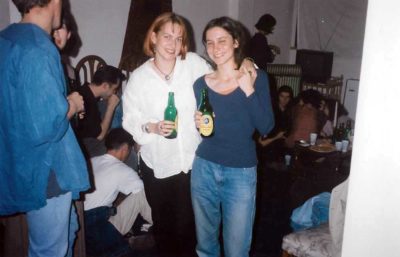
Sanna (L) enjoying a Stella with friends at a party in Cairo.
Like many, I had come to Cairo to enhance my Arabic. An integral part of student life was of course partying, a pastime I eagerly participated in. It was mostly house parties, but also those held in strange bars and nightclubs with Sudanese prostitutes, German pimps, and gay boys. And we always drank Stella, lots of it.
I came to learn that every bottle was unique, not because it was craft beer, but because of what was a serious ma’alesh attitude at the assembly line. Some were bitter; some were citrusy, and some watery. There were flat ones, and ones with ash at the bottom like snow globes. That’s why in those days it was commonplace to take an exploratory sip at the bar. If it was unsatisfactory, you’d return it, no questions asked.
Despite these surprises, Stella was a really decent lager. In 1990s Cairo there was the option of beer, arak, or ghastly wine. So it was always beer. A good party ended with 300 empty Stella bottles, and, on a good night out, there were so many bottles on the table there was no room for an ashtray. Until I came to Cairo, I had never been to a bar where a waiter just counted the bottles on the table at the end of the evening. That was Hurriya Café where I learned to play chess from another Stella drinker. When practicing, we only ate candy and drank Stella.
Then came the rivals, beers named after pyramids and historic towns. We learned how to drink beer in a can or a glass and got accustomed to a solid, even taste. But you cannot drink Stella from a can. It has to be that thick green bottle, which is recycled and refashioned into glass, perfect for one more Stella.”
Sanna Ra, Journalist, Helsinki, Finland
“In the 40 years that I have been connected to Egypt, there are many stories I could tell about Stella, but the most appropriate for this 120-year anniversary happened 20 years ago, while I was working on Stella’s centennial celebrations. At the time, I proposed doing a booklet showcasing the history of Stella, which Al Ahram Beverage Company (the parent company) could give away as a gift.
One day I was in my studio with my assistant Ahmed, trying to come up with a cover photograph for the booklet. I had a vintage beer glass from the early 1960s with the word “Stella” written near the rim. My idea was to fill the glass with beer, so that the foam would rise up and spill over the rim and down the sides of the glass partially covering the word “Stella.”
This was back before I had a digital camera, so there was no way of knowing if I had captured the perfect shot until I the film was developed. The best solution was to shoot a lot of images in the hope of capturing the perfect one.
After setting up my medium format camera, the backdrop, and lighting, I called Ahmed over to be the official beer pourer and glass washer. Since I only had the one vintage glass, Ahmed would have to pour the beer into the glass, wait for me to shoot and then dump the content, clean and dry the glass, and get ready for the next round.
After the first take Ahmed took the glass, drank the beer, and then went back into the kitchen to rinse and dry the glass. I knew Ahmed liked beer and I was happy to see him not waste the content, but after the first few rounds I explained to him that this could take some time because I had no way of knowing whether I had the perfect shot until the film was developed. Still, Ahmed continued to drink up after each round of shooting.
I don’t know exactly how many setups we did before Ahmed finally had to use the restroom, but I estimate there were close to 20. Anyway, while he was gone, I tried to pour the beer myself and then shoot the photograph but ended up with a huge mess instead. A bit frustrated, I called out for Ahmed, who had been gone for quite some time, and when I got no response I went to check on him. On my way down the hallway, I peeked into one of the rooms and found him flat on his back on a couch snoring.
In the end we managed to get the perfect shot, but much to our disapointment the designers hired by ABC vetoed my idea and went with something completely different for the cover.”
Norbert Schiller, Curator at Photorientalist and Negativecolors
“It was Thursday, October 8, 1981. A state of emergency had brought an eerie quiet to Cairo’s streets that morning. Soldiers in armored personnel carriers were on guard at every corner and government building. Public gatherings were banned, and telephone lines had been jammed since October 6, when Islamic extremists had assassinated President Anwar al-Sadat and ten other officials as they attended a military parade.
At approximately 10:00 that morning, a Marine guard of my acquaintance permitted me to call my family from inside the US Embassy. After letting them know I was safe, I stopped in the foyer to discuss the assassination and its potential consequences with an American diplomat. As we spoke, Walter Cronkite, accompanied by an aide and a Marine guard, entered the room. Mr. Cronkite shook hands all around and we chatted briefly, then the guard led him down the hall to meet Ambassador Alfred Atherton, with whom he had scheduled an interview. I thanked the Marine on duty, walked across the manicured lawn, and exited the embassy compound through the main gate. Turning right, I walked toward Tahrir Square.
Despite the prohibition against public gatherings, a group of about thirty Egyptians had clustered on the sidewalk across from the Omar Makran Mosque, about a block from the embassy. A larger group was exiting the mosque and getting into waiting limousines. As I stood watching the proceedings, I couldn’t help but notice a young woman ahead of me in the crowd. She had tightly curled blonde hair and was wearing a pink shirt with a navy skirt. I assumed she was German, but I approached her anyway with the hope that she might speak English and could explain what was going on. In fact, she was American, named Sarah, and she taught 4th grade English at Ramses College for Girls. In response to my question, she told me this was the funeral procession for one of the government ministers who had been assassinated with President Sadat. But after she had spoken her first sentence, I became unable to concentrate on what she was saying. Sarah was a paragon of blue-eyed wholesomeness, with a smile as natural as a summer breeze and as radiant as the sun. Mesmerized, I stared dumbly at her, and when I tried to speak, I only managed a few stammered words. In truth, I don’t recall what I said, but I must have uttered at least a few coherent lines, for as she turned and waved goodbye, she said, “I look forward to seeing you at 6:00.” Six o’clock? Yes. Despite my awkwardness, I had asked Sarah if she would join me for a drink on the terrace of Shepherd’s Hotel.
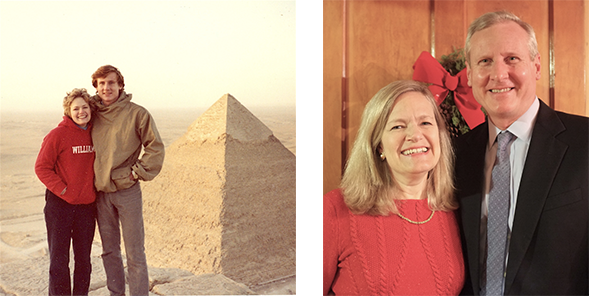
Robert and Sarah atop Cheops Pyramid in 1981 shortly after they drank their first Stella beer together. Nearly 40 years later they are still going strong.
I arrived at the hotel an hour early and secured a good table. At 6:15 I watched Sarah, smiling and freshly dressed for the evening, float toward me like a goddess. The waiter brought two bottles of Stella beer and a small bowl of peanuts. As Sarah and I talked, we watched the sun drift low and red behind the pyramids of Giza. The hours passed. The city lights came on. Sarah draped a cashmere sweater over her shoulders against the chill. We ordered curried chicken with rice, and more Stella. We talked and laughed, and laughed and talked, and the world was far away. Eventually, the waiter interrupted us to announce that the restaurant was closing. I walked Sarah to the taxi stand and we said goodbye. As the taxi pulled away, I saw her turn and wave in the back seat.
Sarah and I saw each other as often as we could during that magical year in Cairo, and a cold Stella accompanied us at each happy meeting. Later that spring, over a candle-lit dinner at the old Carroll’s restaurant, I raised my glass of Stella and proposed marriage to Sarah, and she raised her glass in acceptance. Ever since that year, on the anniversary of our meeting, Sarah and I raise a glass of beer and remember that first magical evening together, and the dreams that Stella helped make a reality.”
Robert Jackson, Desert Explorer, Sailor and Adventurer
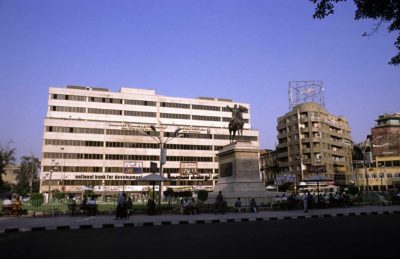
The ugly parking garage on Opera Square that replaced the opera house after it burned down.
“Just behind Opera Square where an ugly garage is now located, there once stood an old building whose ground floor comprised a graceful arcade, like those still visible behind the clutter of merchandise in Ataba. In the pastoral early 80s you could wander comfortably around this area. The criminal flyover above Shara al-Azhar had not yet been perpetrated; the streets ran clear and true. This particular building was decaying even then, its second floor missing a few walls, but it was a grand heap of rubble, a noble ruin. Beneath the arcade on street level were several establishments with their own derelict nobility. One was a Stella bar and it had swinging doors just like the saloons you see in cowboy movies.
There was something of the frontier town in that watering hole. The ambiance was festive – not furtive, the way neighborhood hooch joints are today. In fact, the crowd could get quite rowdy but only in the way that an attentive audience enjoying a bit of theater will occasionally coalesce into merriment or derision. Mostly people sat at the wooden tables and listened to the radio or talked while they sipped and smoked and nibbled thermis dropping the skins on the sawdust-covered floor. Entrances and exits provided the clientele with entertainment and one could expect a flurry of greetings from inebriated strangers upon arrival.
One midwinter’s night, armed with a mighty thirst, I’d stopped by after a long foray into the depths of the Old City. I neatly quaffed a soothing Stella, but its mild alcoholic content could not have accounted for the apparition I suddenly beheld standing within the still swinging doors of the saloon. Silence pierced the room. The creature on the threshold resembled a huge furry bear. Closer examination revealed a thickly bearded man dressed in animal skins ala Neanderthal, topped off with cowl-shaped hat that trailed the tail of what may have once been a fox. Around his waist was a leather strap from which hung a variety of crude implements. He glowered for a moment at the room, whose inhabitants quickly and politely returned to their drinks. I however, remained transfixed by this creature that seemed to have stepped directly out of the Ice Age.
Perhaps that’s why he chose to come to my table and with a gruff wordless gesture, ask if he could join me. I responded with a dumbfounded nod of assent. Never argue with a giant dressed in deerskin with a hatchet hanging from his belt, that’s what I always say. I hardly had time to wonder what fatal attraction I held for the cave-man type when I saw several shriveled leathery objects dangling from his makeshift utility belt. I gulped and instantly looked away but he’d noticed and fixed me with a wily amber-colored gaze. I swallowed hard and he threw his boulder-sized head back in a startling burst of hearty laughter.
I smiled queasily but just then, to my horror, a waiter shuffled over and placed a small bottle of local brandy in front of my prehistoric companion and a fresh Stella in front of me. I began to protest but was silenced by another sharp yellow look before the friendly hulk drained his bottle in a single draught. I’m not a big beer drinker but I knocked that Stella back faster than you can say homo sapiens sapiens.
The man grunted with satisfaction, tilted his head to one side and gave me an uncannily penetrating look, the kind I imagine a lion might give if you were pinned beneath its paws. But it wasn’t an animal look in the sense of dumb, nor did it carry malice or threat of violence; it was just that what seemed to be a different sort of intelligence was directed my way from behind those fiercely present amber eyes. He stood and took a deep breath, swelling his barrel chest even larger. And then with a swift round gesture he produced three pure white doves from somewhere beneath his tunic.
He cast them into the air and they circled the room once or twice before finding an open window and flying off into the night. We all ducked and watched, awestruck, until someone began to laugh and was joined by everyone else in the room. That first incredulous laughter was my own and the sound of it amidst the flapping of wings will never leave me. Nor will the golden gaze of the magician who strode out through the swinging doors chuckling and shaking his great round head.”
Maria Golia, Author, Cairo, Egypt
Anyone with a Stella memory they want to share please email me: nschiller@photorientalist.org
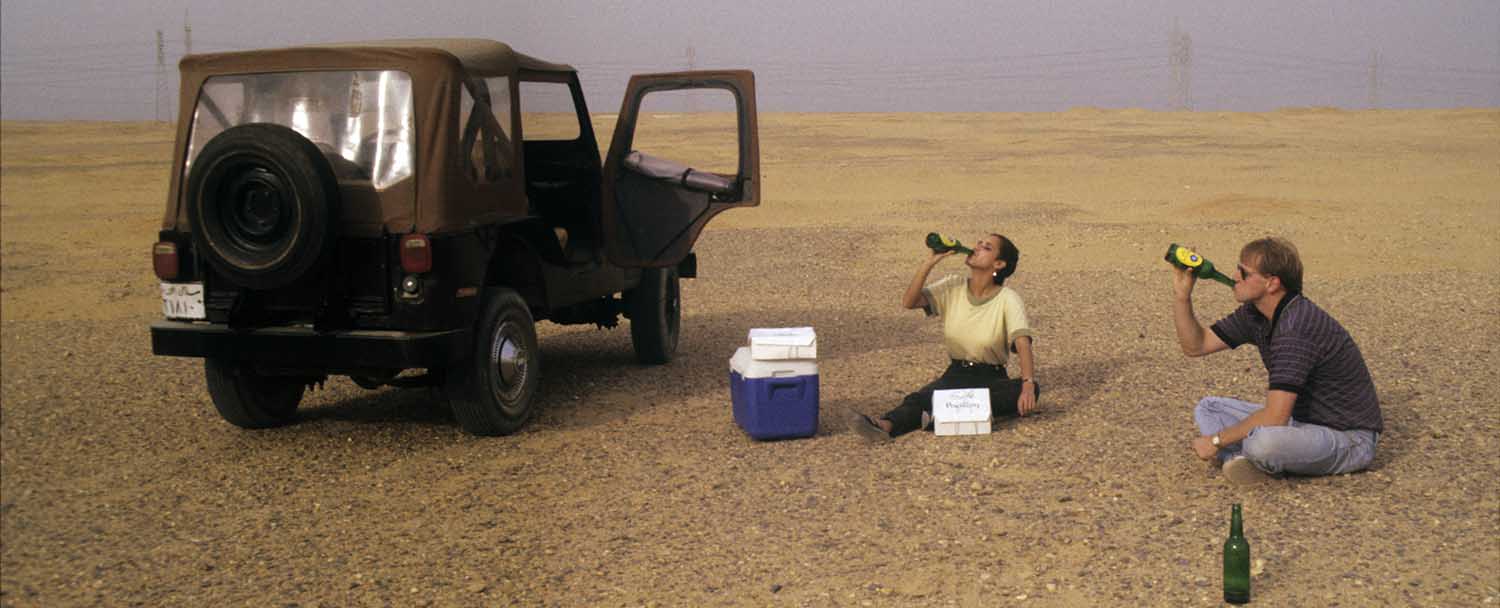
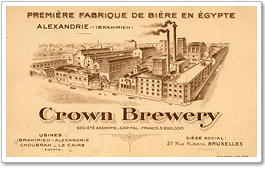
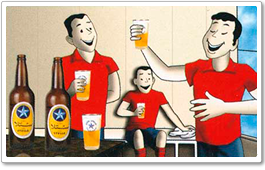
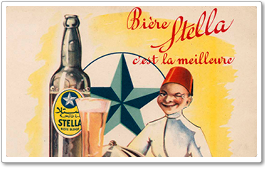
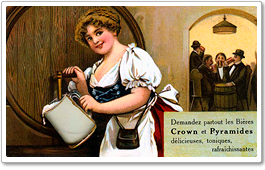

Very good Work . Excellent. I was born in Alexandria
Excellent Woerk , I know Stella because I was born in Alexandria
Excellent